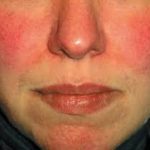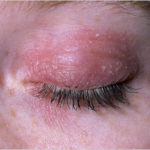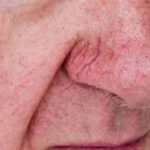Let’s get the RED out: Causes and treatments for red skin
Red skin is more common than you may think. There are a multitude of conditions that can cause your red skin and the discomfort that may accompany it. Here are some common causes and treatments for red skin.
- Seborrheic dermatitis – Seborrheic dermatitis is a common skin condition that causes
 a red rash, which often appears on the face and scalp. The rash may cause the skin to look oily, flakey or have a yellow scale. Seborrheic dermatitis is caused by an overgrowth of yeast on your skin. It can be controlled by shampooing with a dandruff shampoo, using it in your eyebrows or any hair bearing areas on the face. If your scalp is affected, shampooing frequently and blow drying your scalp can assist in treating the seborrheic dermatitis. Ketaconazole topical cream can be used when you are experiencing an outbreak.
a red rash, which often appears on the face and scalp. The rash may cause the skin to look oily, flakey or have a yellow scale. Seborrheic dermatitis is caused by an overgrowth of yeast on your skin. It can be controlled by shampooing with a dandruff shampoo, using it in your eyebrows or any hair bearing areas on the face. If your scalp is affected, shampooing frequently and blow drying your scalp can assist in treating the seborrheic dermatitis. Ketaconazole topical cream can be used when you are experiencing an outbreak. - Rosacea – This skin condition often begins with a tendency to flush or blush easily. The condition can be exacerbated by spicy foods or alcohol. If the condition progresses, you
 many notice that the redness on your face lasts longer — or never fades. You may also develop acne-like papules and facial telangectasisis (broken or dilated blood vessels). While rosacea cannot be cured, treatment can lessen the redness. There are topical treatments that can lessen the symptoms of rosacea. Topicals such as soolantra, an ivermectin cream, helps to slow the progression and sulphur based topicals can be helpful too. Oral doxycycline in a low dose can decrease your redness and keep symptoms at bay. Many patients opt to treat their rosacea with laser. Vbeam Perfecta, a vascular laser, can reduce flushing and facial redness leading to increased comfort.
many notice that the redness on your face lasts longer — or never fades. You may also develop acne-like papules and facial telangectasisis (broken or dilated blood vessels). While rosacea cannot be cured, treatment can lessen the redness. There are topical treatments that can lessen the symptoms of rosacea. Topicals such as soolantra, an ivermectin cream, helps to slow the progression and sulphur based topicals can be helpful too. Oral doxycycline in a low dose can decrease your redness and keep symptoms at bay. Many patients opt to treat their rosacea with laser. Vbeam Perfecta, a vascular laser, can reduce flushing and facial redness leading to increased comfort. - Contact dermatitis develops when something that touches your skin either irritates it or causes an allergic reaction. The face is a common place to get contact dermatitis. A
 soap or hair dye can irritate your skin, causing a condition known as irritant contact dermatitis. If you are allergic to what touches your face, you can develop allergic contact dermatitis. Common causes of allergic contact dermatitis include poison ivy, fragrances, and latex. This rash tends to clear on its own when you stop exposing your skin to whatever is causing the reaction. In the interim an over-the-counter topical corticosteroid cream may be applied to alleviate symptoms.
soap or hair dye can irritate your skin, causing a condition known as irritant contact dermatitis. If you are allergic to what touches your face, you can develop allergic contact dermatitis. Common causes of allergic contact dermatitis include poison ivy, fragrances, and latex. This rash tends to clear on its own when you stop exposing your skin to whatever is causing the reaction. In the interim an over-the-counter topical corticosteroid cream may be applied to alleviate symptoms. - Spider veins-If you don’t protect your skin from the sun, the harmful rays can damage
 your skin. Over the years, this damage accumulates. Years later, some people who have sun-damaged skin see spider veins on their face. A board-certified dermatologist can treat your spider veins with VBeam Perfect laser treatment Medical insurance does not cover this treatment.
your skin. Over the years, this damage accumulates. Years later, some people who have sun-damaged skin see spider veins on their face. A board-certified dermatologist can treat your spider veins with VBeam Perfect laser treatment Medical insurance does not cover this treatment.
To schedule an appointment with our board certified dermatologist, Deborah H. Atkin, M.D. contact us.


